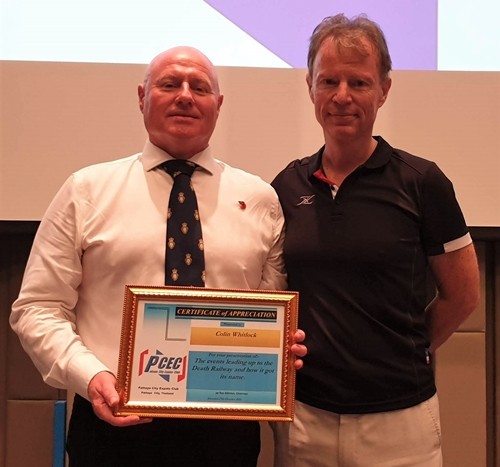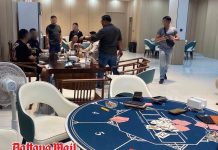
Colin Whitlock gave a very informative talk to the Pattaya City Expats Club (PCEC) on October 27. He started by commenting on the beauty of Kanchanaburi Province today. The area is colorful, diverse and worth seeing with its floating markets, waterfalls, lakes, hot springs, elephants and caves.
Kanchanaburi City lies at the confluence of two rivers, the Kwai Noi and the Kwai Yai, and is also a popular tourist destination, especially to see the Bridge on the River Kwai made famous in a movie of the same name which depicted British and allied soldiers forced to build a railway supply line to Burma. His talk then focused on the construction of this railroad by the Japanese during World War II. He noted that Kanchanaburi also houses a war museum depicting the horrors of the construction of the Death Railway by the Japanese in World War II.
In commenting on the Death Railway, he said it got this infamous name because of the many prisoners of war who were forced to labor on its construction died not only because the brutality of their Japanese and Korean guard, but also because the working and living conditions were inhumane. The cost in human suffering was punitive, too many men never returning home. Colin said these sacrifices must not be forgotten, especially at this time of the year when we remember the fallen.
He then delved into the history of the Death Railway. Japanese forces crossed the border into Thailand on the 8th December 1941 and due to the time difference, it was just 90 minutes ahead of the Japanese attack on Pearl Harbor. The Thai government could not oppose the powerful Japanese advance into Southeast Asia and as a result announced its cooperation with the Japanese.
As early as 1939, Japanese agents in Thailand were preparing the ground for the construction of the railway to be carried out once the Japanese forces had taken control of the area. The railway was intended purely as a military supply line for the movement of troops and equipment to the Burma Front, and ultimately for the invasion of India. This project aimed to link Ban Pong in Thailand with Thanbyuzayat in Burma. Some 12,000 Japanese soldiers and 800 Koreans were employed as engineers, guards and supervisors. Despite having better living conditions than the POWs and Asian laborers, 1,000 Japanese also died during the construction.
Approximately 62,000 Allied prisoners of war were subject to forced labour during its construction. In May 1942 the first prisoners of War, 3,000 POWs were sent by sea to Burma from Changi prison in Singapore. More prisoners were imported from Singapore and the Dutch East Indies as construction advanced. Construction camps were placed every 5-10 miles of the route. These consisted of open sided barracks built of bamboo poles with thatched roofs. Sixty meters long with sleeping platforms raised above the ground. Two hundred men were housed in each barracks, giving a two-foot space in which to live and sleep.
The prisoners were at the bottom of a system that was harsh, punitive, fanatical and too often deadly. Living and working conditions were horrific, with sickness, maltreatment and starvation. Normal work on the railway was backbreaking, often without the necessary tools. The workers subjected to tropical conditions, living in squalor without basic hygiene and lack of enough food. Many died of exhaustion, dysentery and cholera, the diet was 600 calories of rice daily, cut to 400 by the war’s end. In addition, they suffered brutality by the Japanese and Korean guards, often beaten to death as part of disciplinary measures. Workdays were long and harsh, especially when cutting through rock at what became known as Hellfire Pass. In the 1980’s the cutting was reclaimed from the jungle as a War Memorial funded by the Australian government.
Japan had initially tried to use an Asian volunteer workforce. When this failed to attract enough workers, they resorted to more brutal methods of impressing laborers, called Romusha in Japanese. It involved approximately 85,000 Malayans, 75,000 Burmese, and 12,000 others. Estimates of Romusha deaths vary widely but the percentages were certainly higher than that of the POW’s. It’s thought that there are several undiscovered mass graves along the track route of the Death Railway bearing the bodies of South East Asian workers. This is supported by the higher end estimated numbers of forced laborers used, and unaccounted for at the end of the conflict.
The Kanchanaburi War Cemetery, known locally as Don Rak, is the final resting place of almost 7,000 POW’s. Chungkai War Cemetery, about two kilometres away has a further 1,700 war graves, whilst at the Thanbyuzzayat War Cemetery are the graves of 3,600 POW’s who died on the Burmese portion of the line. It is thought one worker died for each wooden sleeper laid, approximately 75 men died each day, 400 men for each mile of the railway.
Colin is active in the British Legion in Thailand whose mission is to provide welfare, comradeship, representation and remembrance for the Armed Forces community. They are also keen to maintain an active role in supporting the Thai War Veterans Organization. Colin is a Veteran. He joined the British Army at the age of 16, serving both with the Junior Leaders regiment RAC and in the 3rd Royal Tank Regiment. Serving in Germany, Canada and Northern Ireland.
After the presentation, the MC brought everyone up to date on upcoming club and other Pattaya events of interest. The meeting ended with the usual Open Forum where audience members can ask questions or make comments about Expat life in Thailand, especially Pattaya. For more info about the PCEC, visit their website at http://pattayacityexpatsclub.com/.
Member Ren Lexander interviewed Colin Whitlock after his presentation to the PCEC. To view the video, visit https://www.youtube.com/watch?v=n5-RWrTPVPw&t=6s.
 |
 |
 |





